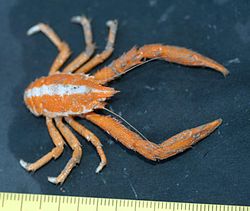| Munidopsis Temporal range: | |
|---|---|
 | |
| Munidopsis serricornis | |
| Scientific classification | |
| Kingdom: | Animalia |
| Phylum: | Arthropoda |
| Class: | Malacostraca |
| Order: | Decapoda |
| Suborder: | Pleocyemata |
| Infraorder: | Anomura |
| Family: | Munidopsidae |
| Genus: | Munidopsis Whiteaves, 1874 |
| Type species | |
| Munidopsis curvirostra Whiteaves, 1874 | |
Munidopsis is a genus of squat lobster. It is the second largest of all the genera of squat lobsters, after Munida , with over 200 species. [1] Its members are mainly found on continental slopes and on abyssal plains. [1] A few fossil species are also known, [2] including specimens from the Campanian (Cretaceous).